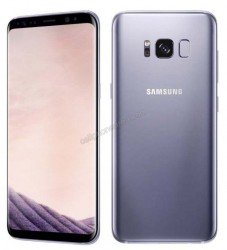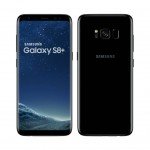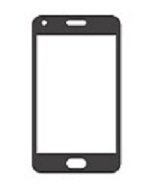Samsung Galaxy S8 vs Samsung Galaxy S8+ Comparison
Here, we compared two smartphones: the Samsung Galaxy S8 and the Samsung Galaxy S8+. The Samsung Galaxy S8 is a 5.8 inches, 84.8 cm2 (~83.6% screen-to-body ratio) phone with a Exynos 8895 (10 nm) - EMEA Qualcomm MSM8998 Snapdragon 835 (10 nm) - USA & China Processor, Announced on 29 Mar, 2017. The Samsung Galaxy S8+ is a 6.2 inches phone with a Exynos 8895 (10 nm) - EMEA Qualcomm MSM8998 Snapdragon 835 (10 nm) - USA & China Processor, Announced on 26 Mar, 2017. This page has information about both phones, including Price, Camera, Display, Performance, RAM, Storage, Battery, Operating System, Network Connectivity, Multimedia, Color, and more.
Samsung Galaxy S8 spotlights
Samsung Galaxy S8 released in 2017, April 24. Firstly, Its dimensional measure is 148.9 x 68.1 x 8 mm (5.86 x 2.68 x 0.31 in) and the weight is 155 g (5.47 oz). Secondly, the display of Samsung Galaxy S8 is a 5.8 inches, 84.8 cm2 (~83.6% screen-to-body ratio) Super AMOLED capacitive touchscreen, 16M colors with 1440 x 2960 pixels, 18.5:9 ratio (~570 ppi density) resolution. It's built with Glass front (Gorilla Glass 5), glass back (Gorilla Glass 5), aluminum frame. Thirdly and most importantly, it is powered by the Exynos 8895 (10 nm) - EMEA Qualcomm MSM8998 Snapdragon 835 (10 nm) - USA & China and running with Android 7.0 (Nougat), upgradable to Android 9.0 (Pie), One UI. Moreover, it has up to an Octa-core (4x2.3 GHz Mongoose M2 & 4x1.7 GHz Cortex-A53) - EMEA Octa-core (4x2.35 GHz Kryo & 4x1.9 GHz Kryo) - USA & China CPU with Mali-G71 MP20 - EMEA Adreno 540 - USA & China GPU.
Samsung Galaxy S8 phone has a Single-camera setup on the back. This formation consists of a 12 MP, f/1.7, 26mm (wide), 1/2.55", 1.4µm, dual pixel PDAF, OIS camera. It has a 8 MP, f/1.7, 25mm (wide), 1/3.6", 1.22µm, AF 2 MP (dedicated iris scanner camera) selfie camera inside the notch of the display. The video recording capability is 4K@30fps, 1080p@30/60fps, 720p@240fps, HDR, stereo sound rec., gyro-EIS, OIS. According to its RAM and ROM, it has 64GB 4GB RAM UFS 2.0 or UFS 2.1 variants. It has a Single SIM (Nano-SIM) or Hybrid Dual SIM (Nano-SIM, dual stand-by) Samsung Pay (Visa, MasterCard certified) IP68 dust/water resistant (up to 1.5m for 30 mins) and also supports - Iris scanner, fingerprint (rear-mounted), accelerometer, gyro, proximity, compass, barometer, heart rate, SpO2 Samsung DeX (desktop experience support) ANT+ Bixby natural language commands and dictation sensors.
Samsung Galaxy S8+ spotlights
Samsung Galaxy S8+ released in 2017, April. Firstly, Its dimensional measure is 159.5 x 73.4 x 8.1 mm and the weight is 173 g. Secondly, the display of Samsung Galaxy S8+ is a 6.2 inches Super AMOLED capacitive touchscreen, 16M colors with 1440 x 2960 pixels, 18.5:9 ratio resolution. It's built with Glass front (Gorilla Glass 5), glass back (Gorilla Glass 5), aluminum frame. Thirdly and most importantly, it is powered by the Exynos 8895 (10 nm) - EMEA Qualcomm MSM8998 Snapdragon 835 (10 nm) - USA & China and running with Android 7.0 (Nougat), upgradable to Android 9.0 (Pie); One U. Moreover, it has up to an Octa-core (4x2.3 GHz Mongoose M2 & 4x1.7 GHz Cortex-A53) - EMEA Octa-core (4x2.35 GHz Kryo & 4x1.9 GHz Kryo) - USA & China CPU with Mali-G71 MP20 - EMEA Adreno 540 - USA & China GPU.
Samsung Galaxy S8+ phone has a Single-camera setup on the back. This formation consists of a 12 MP, f/1.7, 26mm (wide), 1/2.55", 1.4µm, dual pixel PDAF, OIS camera. It has a 8 MP, f/1.7, 25mm (wide), 1/3.6", 1.22µm, AF selfie camera inside the notch of the display. The video recording capability is 2160p@30fps, 1080p@30/60fps, 720p@240fps, HDR, dual-video rec., stereo sound rec., gyro-EIS, OIS. According to its RAM and ROM, it has 64GB 4GB RAM, 128GB 6GB RAM UFS 2.0 or UFS 2.1 variants. It has a Single SIM (Nano-SIM) or Hybrid Dual SIM (Nano-SIM, dual stand-by) and also supports - Iris scanner, fingerprint (rear-mounted), accelerometer, gyro, proximity, compass, barometer, heart rate, SpO2 sensors.


